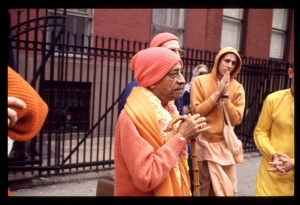SB 10.6.5-6: Difference between revisions
m (1 revision(s)) |
No edit summary |
||
| Line 1: | Line 1: | ||
{{info | {{info | ||
|speaker= | |speaker=Śukadeva Gosvāmī | ||
|listener=King | |listener=King Parīkṣit | ||
}} | }} | ||
[[Category:Srimad-Bhagavatam - Canto 10 Chapter 06|s05-06 ]] | |||
[[Category:Bhagavatam Verses Spoken by Sukadeva Gosvami - Vanisource|100605]] | |||
<div style="float:left">'''[[Srimad-Bhagavatam]] - [[SB 10|Tenth Canto]] - [[SB 10.6: The Killing of the Demon Putana|Chapter 6: The Killing of the Demon Pūtanā]]'''</div> | |||
<div style="float:right">[[File:Go-previous.png|link=SB 10.6.4]] '''[[SB 10.6.4]] - [[SB 10.6.7]]''' [[File:Go-next.png|link=SB 10.6.7]]</div> | |||
{{RandomImage}} | |||
==== TEXTS 5-6 ==== | ==== TEXTS 5-6 ==== | ||
<div | <div class="verse"> | ||
tāṁ keśa-bandha-vyatiṣakta-mallikāṁ | :tāṁ keśa-bandha-vyatiṣakta-mallikāṁ | ||
bṛhan-nitamba-stana-kṛcchra-madhyamām | :bṛhan-nitamba-stana-kṛcchra-madhyamām | ||
suvāsasaṁ kalpita-karṇa-bhūṣaṇa- | :suvāsasaṁ kalpita-karṇa-bhūṣaṇa- | ||
tviṣollasat-kuntala-maṇḍitānanām | :tviṣollasat-kuntala-maṇḍitānanām | ||
valgu-smitāpāṅga-visarga-vīkṣitair | |||
mano harantīṁ vanitāṁ vrajaukasām | :valgu-smitāpāṅga-visarga-vīkṣitair | ||
amaṁsatāmbhoja-kareṇa rūpiṇīṁ | :mano harantīṁ vanitāṁ vrajaukasām | ||
gopyaḥ śriyaṁ draṣṭum ivāgatāṁ patim | :amaṁsatāmbhoja-kareṇa rūpiṇīṁ | ||
:gopyaḥ śriyaṁ draṣṭum ivāgatāṁ patim | |||
</div> | </div> | ||
| Line 21: | Line 27: | ||
==== SYNONYMS ==== | ==== SYNONYMS ==== | ||
<div | <div class="synonyms"> | ||
''tām''—her; ''keśa-bandha-vyatiṣakta-mallikām''—whose arrangement of hair was decorated with a garland of ''mallikā'' flowers; ''bṛhat''—very, very big; ''nitamba-stana''—by her hips and firm breasts; ''kṛcchra-madhyamām''—whose slim waist was overburdened; ''su-vāsasam''—nicely painted or very attractively dressed; ''kalpita-karṇa-bhūṣaṇa''—of the earrings arranged on her ears; ''tviṣā''—by the brilliance; ''ullasat''—very attractive; ''kuntala-maṇḍita-ānanām''—whose beautiful face was surrounded by black hair; ''valgu-smita-apāṅga-visarga-vīkṣitaiḥ''—by her casting her smiling glance on everyone very attractively; ''manaḥ harantīm''—everyone's attention was attracted (by her); ''vanitām''—an especially attractive woman; ''vraja-okasām''—of the inhabitants of Gokula; ''amaṁsata''—thought; ''ambhoja''—holding a lotus flower; ''kareṇa''—with her hand; ''rūpiṇīm''—very beautiful; ''gopyaḥ''—the ''gopī'' inhabitants of Gokula; ''śriyam''—the goddess of fortune; ''draṣṭum''—to see; ''iva''—as if; ''āgatām''—had come; ''patim''—her husband. | |||
</div> | </div> | ||
| Line 28: | Line 34: | ||
==== TRANSLATION ==== | ==== TRANSLATION ==== | ||
<div | <div class="translation"> | ||
Her hips were full, her breasts were large and firm, seeming to overburden her slim waist, and she was dressed very nicely. Her hair, adorned with a garland of mallikā flowers, was scattered about her beautiful face. Her earrings were brilliant, and as she smiled very attractively, glancing upon everyone, her beauty drew the attention of all the inhabitants of Vraja, especially the men. When the gopīs saw her, they thought that the beautiful goddess of fortune, holding a lotus flower in her hand, had come to see her husband, Kṛṣṇa. | Her hips were full, her breasts were large and firm, seeming to overburden her slim waist, and she was dressed very nicely. Her hair, adorned with a garland of mallikā flowers, was scattered about her beautiful face. Her earrings were brilliant, and as she smiled very attractively, glancing upon everyone, her beauty drew the attention of all the inhabitants of Vraja, especially the men. When the gopīs saw her, they thought that the beautiful goddess of fortune, holding a lotus flower in her hand, had come to see her husband, Kṛṣṇa. | ||
</div> | </div> | ||
__NOTOC__ | |||
<div style="float:right; clear:both;">[[File:Go-previous.png|link=SB 10.6.4]] '''[[SB 10.6.4]] - [[SB 10.6.7]]''' [[File:Go-next.png|link=SB 10.6.7]]</div> | |||
__NOTOC__ | |||
__NOEDITSECTION__ | |||
Revision as of 07:50, 19 May 2021

A.C. Bhaktivedanta Swami Prabhupada
TEXTS 5-6
- tāṁ keśa-bandha-vyatiṣakta-mallikāṁ
- bṛhan-nitamba-stana-kṛcchra-madhyamām
- suvāsasaṁ kalpita-karṇa-bhūṣaṇa-
- tviṣollasat-kuntala-maṇḍitānanām
- valgu-smitāpāṅga-visarga-vīkṣitair
- mano harantīṁ vanitāṁ vrajaukasām
- amaṁsatāmbhoja-kareṇa rūpiṇīṁ
- gopyaḥ śriyaṁ draṣṭum ivāgatāṁ patim
SYNONYMS
tām—her; keśa-bandha-vyatiṣakta-mallikām—whose arrangement of hair was decorated with a garland of mallikā flowers; bṛhat—very, very big; nitamba-stana—by her hips and firm breasts; kṛcchra-madhyamām—whose slim waist was overburdened; su-vāsasam—nicely painted or very attractively dressed; kalpita-karṇa-bhūṣaṇa—of the earrings arranged on her ears; tviṣā—by the brilliance; ullasat—very attractive; kuntala-maṇḍita-ānanām—whose beautiful face was surrounded by black hair; valgu-smita-apāṅga-visarga-vīkṣitaiḥ—by her casting her smiling glance on everyone very attractively; manaḥ harantīm—everyone's attention was attracted (by her); vanitām—an especially attractive woman; vraja-okasām—of the inhabitants of Gokula; amaṁsata—thought; ambhoja—holding a lotus flower; kareṇa—with her hand; rūpiṇīm—very beautiful; gopyaḥ—the gopī inhabitants of Gokula; śriyam—the goddess of fortune; draṣṭum—to see; iva—as if; āgatām—had come; patim—her husband.
TRANSLATION
Her hips were full, her breasts were large and firm, seeming to overburden her slim waist, and she was dressed very nicely. Her hair, adorned with a garland of mallikā flowers, was scattered about her beautiful face. Her earrings were brilliant, and as she smiled very attractively, glancing upon everyone, her beauty drew the attention of all the inhabitants of Vraja, especially the men. When the gopīs saw her, they thought that the beautiful goddess of fortune, holding a lotus flower in her hand, had come to see her husband, Kṛṣṇa.